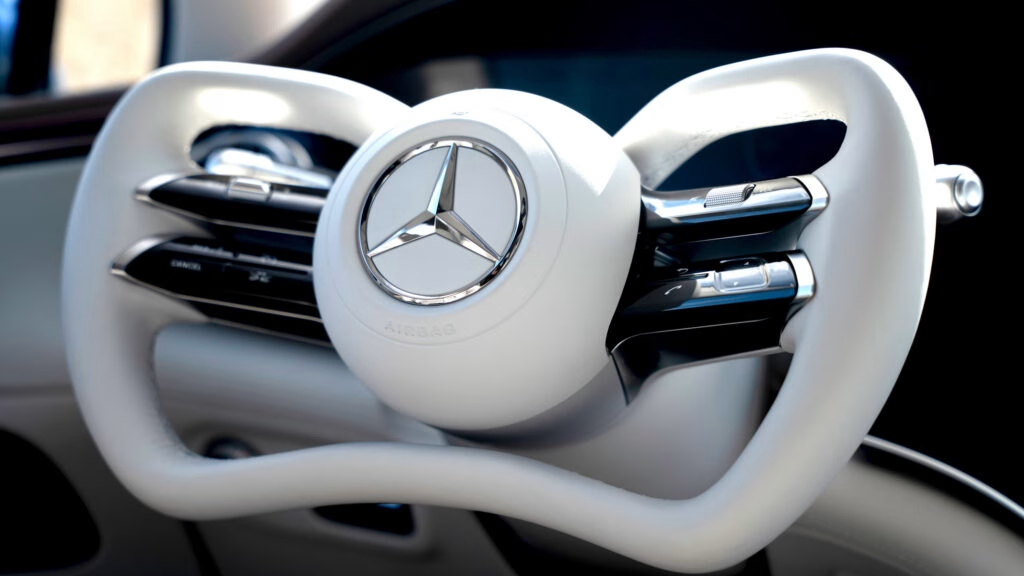Mercedes-Benz is stepping into the future of driving with its innovative steer-by-wire system, set to debut in production vehicles by 2026. This cutting-edge technology replaces the traditional mechanical connection between the steering wheel and the wheels with an electrical system, allowing for a more responsive and agile driving experience. But what does this mean for drivers, and how does it stack up against conventional steering systems? Let’s dive into the details.
What Is Steer-By-Wire and How Does It Work?
At its core, steer-by-wire technology eliminates the physical link between the steering wheel and the vehicle’s wheels. Instead, it uses electrical signals to communicate the driver’s intentions to the vehicle. This shift not only enhances the responsiveness of the steering but also opens up new possibilities for vehicle design. For instance, Mercedes is introducing a yoke-shaped steering wheel, which is not only stylish but also aims to improve cabin space and visibility.
This system has undergone extensive testing, clocking over a million kilometers on test benches and real-world conditions. Mercedes emphasizes safety, incorporating redundant systems and backup power supplies to ensure that drivers can maintain control even in the unlikely event of a failure.
The Yoke Design: A Game Changer or a Gimmick?
The yoke-shaped steering wheel has sparked a mix of excitement and skepticism. On one hand, it’s designed to free up space in the cockpit, making entry and exit easier while providing an unobstructed view of the digital instrument cluster. Additionally, the yoke can be utilized for in-car entertainment, particularly in autonomous vehicles where the driver may not need to focus on steering.
However, not everyone is convinced that the yoke is a practical solution. Critics argue that it complicates basic driving tasks, such as turning at low speeds or parking. The traditional steering wheel offers a level of comfort and control that a yoke may not replicate, leading some to view this innovation as more style than substance.
The Future of Driving: Enhanced Experiences
Mercedes-Benz’s Chief Technology Officer, Markus Schafer, sees steer-by-wire as a pivotal advancement in the evolution of mobility. He suggests that this technology will enhance the driving experience beyond mere steering, especially when combined with conditionally automated driving systems. Imagine streaming your favorite show on a digital display while the car handles the driving—this is the immersive future Mercedes envisions.
Safety First: How Does It Ensure Reliability?
Safety is a paramount concern with any new automotive technology, and Mercedes has taken significant steps to address this. The steer-by-wire system features a redundant architecture, meaning that if one part fails, there are backups in place to maintain control. This includes lateral guidance through rear-axle steering and targeted braking interventions on individual wheels, ensuring that drivers can still navigate safely even in emergencies.
A Look at the Competition
Mercedes isn’t alone in exploring steer-by-wire technology. Other manufacturers, including Tesla, General Motors, and Lexus, are also integrating similar systems into their vehicles. The Lexus RZ 405e is set to be the first to introduce this technology to Europe, showcasing the growing trend towards electronic steering solutions.
The Evolution of Steering Systems
Interestingly, the concept of alternative steering mechanisms isn’t new for Mercedes. The company has a rich history of experimenting with various steering designs, dating back to the first automobile, Carl Benz’s 1886 Patent Motorwagen, which featured a steering crank. Over the years, Mercedes has explored futuristic concepts, including joystick controls in earlier models, demonstrating a long-standing commitment to innovation.
As Mercedes-Benz prepares to roll out its steer-by-wire system, it’s clear that this technology represents a significant leap forward in automotive design and functionality. While the yoke-shaped steering wheel may raise eyebrows, the potential for enhanced driving experiences and safety features cannot be overlooked. Whether this innovation will resonate with drivers remains to be seen, but one thing is certain: the future of driving is evolving, and Mercedes is at the forefront of this transformation.

